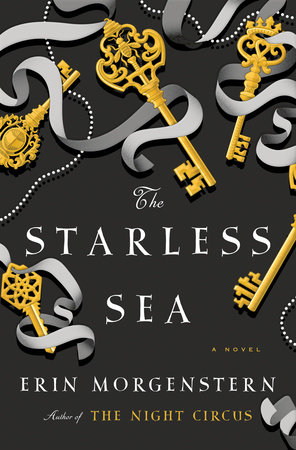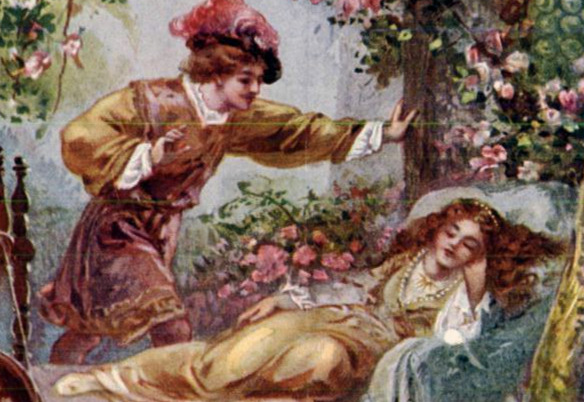interviews
A Magical Door That Lets You Wander Inside A Book
Erin Morgenstern, author of "The Starless Sea," on finding inspiration in video games and immersive theater

Erin Morgenstern writes big, magical books that you can wander around inside. The Starless Sea, her follow up to world-beating bestseller The Night Circus, is a twisting maze made of stories. It follows the adventures of Zachary Ezra Rawlins who once, as a boy, encountered a magical door and failed to open it. Zachary gets another chance years later when, as a grad student in Emerging Media, he stumbles across a mysterious book in which his younger self is a character (alongside arcane rituals, gigantic dollhouses, and a romantic but metaphorical pirate.)
The book becomes Zachary’s key to a vast underground refuge of tunnels and rooms, an unconventional library where narratives appear in all formats, not just the bound and written. He also finds himself at the center of an international conspiracy, choosing sides in the schism of a secret society dedicated to protecting and maintaining the Starless Sea.
I’m a playwright, so when I first read The Night Circus, I was pleased but not surprised to read about Morgenstern’s theatre degree, and the inspiration she drew from Punchdrunk, the company behind pioneering immersive theater work Sleep No More. Her novels have an incredibly strong sense of place, but that place feels designed rather than described, almost like a set. I love that I write stories that take place on sets, but I happily offload them to entire teams. I couldn’t get over Morgenstern’s ability to create haunting and complete environments with the written word.
The Starless Sea (the novel, not the place) references classic literature alongside geeky pop culture of all genres. (If I wanted to, I could prove that the whole thing functions as an adaptation of the opening credits sequence from the classic David Bowie vehicle Labyrinth, and if you know what I’m talking about, you’ll know that’s a good thing.) At the same time, the images Morgenstern creates feel like they are derived from a new mythos. Or rather, they feel like an old mythos that you’re reading for the first time. It’s both dense and expansive, and while it’s firmly a novel, it betrays a fascination with storytelling in all of its limitless possibilities.
Erin Morgenstern and I talked over email about immersion, meta-narratives, and 1980s portal fantasies.
Reina Hardy: The Starless Sea almost feels like an uber-portal fantasy. Can you talk a bit about the portal fantasy genre, and why you chose to write in it and what it means to you?
Erin Morgenstern: I grew up on portal fantasies. I love fantasy in general but there’s something about a portal fantasy that always captured my imagination in a particular way. Alice’s Adventures in Wonderland and Through the Looking-Glass and What Alice Found There were likely the original ones that grabbed on and didn’t let go (I spent my senior year of college adapting & directing them for the stage) but I also read and re-read this series of very 1980s books called The Secret of the Unicorn Queen where a “normal” 80s teen girl gets transported to a world of unicorn-riding warrior women. I would have thought I imagined them entirely but I still have my copies and once in a while I meet someone around my age who remembers them, too. I’m also just the right age where the movie Labyrinth was a formative experience on multiple levels.
I love fantasy that brushes up against the real world, magic that’s hidden from the everyday but close enough to be found.
I think there’s something fascinating about the idea that there is another place, a different place, a magical place and that it can be accessed from the everyday world if only you find the right rabbit hole or structurally unsound wardrobe and then getting there can be as simple as opening a door. I love a fantasy that brushes up against the real world, magic that’s hidden from the everyday but close enough to be found if you know where to look.
I didn’t actively approach The Starless Sea as a portal fantasy, at least not in a classic sense. Though it plays with related tropes and there are a great many doors the sea and its harbors exist in the same world as the rest of the book, it’s just that accessing that space gets complicated. But I did want it to be conscious of other pre-existing fantasy worlds, so Zachary has been reading The Chronicles of Narnia and those types of books his entire life and has the reference points for them. And then I’m able to use those reference points but continue beyond them into something new.
RH: The early image of Zachary in front of the painted door is so powerful. I can’t stop thinking about the line “if he does not try he cannot be disappointed, and he can go on believing.”
EM: I tried to call extra attention to that moment, to make it significant because it’s many moments at once. It’s an instigating incident that ends up not instigating, an opportunity waiting to be missed. It’s a crossroads.
In an earlier draft, I’d thought maybe Zachary did open that door when he was a kid and had already visited this place and probably wrote it off as a dream or a moment of particularly over-active imagination. But the more I thought about it the more I wanted to leave that door closed, to let it be a “what if?” that hung there in his past. What if you didn’t follow that rabbit down the rabbit hole, even though the chasing of it felt significant at the time? Do you think about that rabbit years later? Does that rabbit haunt you?
The instigating image moment is so vivid in that sort of story. Just that single moment illustrated can call up the entire adventure afterward once you know what it means and where it’s going. The rabbit disappearing down the rabbit hole, the shadowed space in the back of a wardrobe that maybe smells like snow. I knew I wanted young Zachary standing in front of that door to feel like those moments, where you could have an illustration of that boy with an unopened painted door and it would encapsulate the entire story. And then that moment is echoed throughout the story with other doors and other moments before they’re opened, which reinforces that initial door. They’re all transitional moments, between the now and the next.
RH: You had four books-within-the-book, all four of them existing within the world of the story, so that you are constantly switching back and forth between the text within a given imaginary book, and a narrative where said book is a physical object. I’m obsessed with this, please talk about it.
EM: I had earlier drafts where Sweet Sorrows was the only book-within-the-book and then after it progressed past that in Zachary’s narrative it felt like something was missing. Plus the more I wrote the more I needed to explore different pieces of the story and increasing the number of books allowed me to do that. I figured once I’d done it once I could do it again (and again, and again) and have it be part of the structure throughout as well as having them each be physical objects that could be interacted with, just like Sweet Sorrows. It didn’t seem right to not let them be read by the characters if they were going to be read by the reader.
And of course, those book stories expand and overlap with the greater narrative because a single book can’t contain the entire story. I like to keep things nice and simple, can you tell?
RH: You have a theatre degree and you’ve noted an indebtedness to immersive theatre companies like Punchdrunk. I’m a theatre person, so I have to ask: is theatre-thinking different for you than other kinds of story-thinking, and how does that show up in your work?
EM: My thinking, both theatre-wise and story-wise, always starts visual. I’m a very visual person so I picture everything and when I’m writing the theatre background kicks in and expands those visuals, blocking out scenes and designing the lighting. (I studied lighting design so I’m always concerned with how spaces are lit, it has such huge impact on mood.)
All forms of storytelling have their merits, and I will fight anyone who tries to discount video game as a storytelling medium.
I’d burnt out on theatre after college to the point of not even going to see anything. But while I was working on The Night Circus, Punchdrunk’s production of Sleep No More opened near Boston and it sounded kind of intriguing so I checked it out. It was the first properly immersive production I’d been to and it was just what I needed, I was already working on a book about an immersive entertainment space and it really expanded my concept of what that could be.
I think in that immersive way when I’m writing now: what is the character or even the reader seeing/hearing/smelling as they work their way through this imaginary space? How can I manipulate it to feel the way I want it to feel? I get to do everything from directing to lighting design to acting all the parts when I’m writing and I think about it in those terms, mentally transposing everything into an immersive, visual medium to try to make it feel like the reader is in these spaces.
RH: Pretty early in the book, Zachary leads an undergraduate discussion group on storytelling in gaming that turns into something of a craft discussion. It almost feels as if you are debating the merits of different methods of storytelling. Is that true,? And why did novels win the debate for you personally?
EM: When I first started working on this book I thought I was writing a book about books and then it slowly started to become a book about stories. Personally, the distinction came down to the fact that a book is a fixed narrative and a story is malleable, but the reasoning was to allow for expanding those storytelling mediums to include everything from myths told by firelight to video games.
I think all forms of storytelling have their merits, and also I will fight anyone who tries to discount video game as a storytelling medium, some of the most interesting storytelling moments I’ve experienced in the last few years have been in games.
I personally favor the novel as a storytelling form because I can do everything by myself with minimal equipment.
RH: Can you talk about the use of puzzles as a storytelling device? Are there puzzles in this book for the reader to solve? (I am definitely not good enough at games to have figured this out for myself!)
EM: There aren’t any secret easter-egg puzzles to be solved within the text or anything like that, I don’t have enough bandwidth in my brain to work that sort of thing in on top of everything else. But I love puzzle as a form even when it’s as simple as a whodunit, I think it makes the reading experience feel more active to have something to think about and problems to solve even if you only have to keep turning the pages to solve them.
I get really fascinated by the way story can be manipulated in game form, that there’s no single, fixed version of a story in a game because it gets to vary for each individual player. I hit on gaming as an area of study for Zachary fairly late, I knew he was in grad school studying something story-related and I had him in my head down to his cable-knit sweaters but English major wasn’t sitting right and then I had moment thinking about narrative structure in video game when I realized that’s what he could be studying and it was one of those pieces that just fell into place perfectly. So he approaches everything that happens to him with a problem-solving, puzzle-centric skill set.
I ended up giving the whole book a video game undertone, I wanted it to feel like there were different options and choices and paths not taken just off the page. If Zachary had made different decisions at different points it could have changed the entire story.
RH: There’s a huge tension in this book around the idea of endings. You reference things like the (famously lost) Library of Alexandria, and you also bring in characters like the story sculptor, who is initially reluctant to sculpt anything that lasts. Your first book, “The Night Circus” is kind of about immortality, but here it seems as if you are circling around the idea that things must end.
EM: Part of the focus on endings came from not being able to figure out how to end the book for a very long time. I rewrote the back half of the book almost entirely three or four times. Someone different was The Owl King in every draft. I’m always interested in endings and points of change and time passing but for this book I definitely kept coming back to the question of what makes an ending an ending.
I also think a lot about story-shapes and arcs and I remember being younger and feeling frustrated that real life didn’t feel story-shaped, that it didn’t have those familiar beats and clear beginnings and middles and ends, because life is so many stories all overlapping and with the boring bits left in.
Some of that thinking about story-shapes always kept bringing me back to how things change and so much of the book is about change and regeneration and letting things grow or die or become something else. And thinking about an ending as another point of change, an ending is a new beginning.
RH: There’s a sense of loss in this book, an idea that this magical place is in decline. Where do you think that sense of loss comes from?
EM: I have a long-standing fascination with abandoned places, bits of architecture that have been retaken by nature or crumbling ruins or even just buildings that are no longer being used for the purposes that they were constructed for. Places that were inhabited at one point and aren’t anymore. Maybe I just love a haunted space but there’s also a sense of time there, a tangible sense of time passing and I think it does have a sense of loss but if someone is viewing it even in a decayed state it’s still there, it’s just changed.
I have a strange relationship with nostalgia, I throw things away and I’m forgetful about large swaths of personal history and I tend to be forward-looking, so even with this idea of a magical space in decline, there’s part of me that wants to examine why you would hold onto it in its previous state instead of letting it go so it can become something new.
RH: Most of the questions I just asked have been circling around the central idea of how you can tell stories—through buildings, books, games, objects. For you, how is that “how” connected to the “why”?
EM: I think the why is part of the how. I think there are so many ways to tell stories and all of it comes down to communication, to shared experiences and emotions and finding ways to relay those to others. We constantly find new ways to tell them and experience them and I love that so many of those storytelling methods are becoming so collaborative because it is an inherently collaborative process between storyteller and story-listener.
While I was trying to write this book I kept asking myself why? Why was I doing it at all, why I was writing a novel, especially in the times that we live in, why is it important and is it important at all and does any of it matter? I don’t know if I found out any answers but I spent 500 pages asking various versions of the question why do we tell stories? We tell stories to reach through time and hold someone else’s hand.









